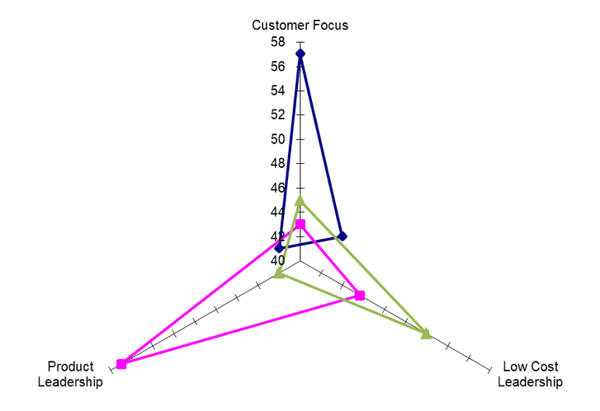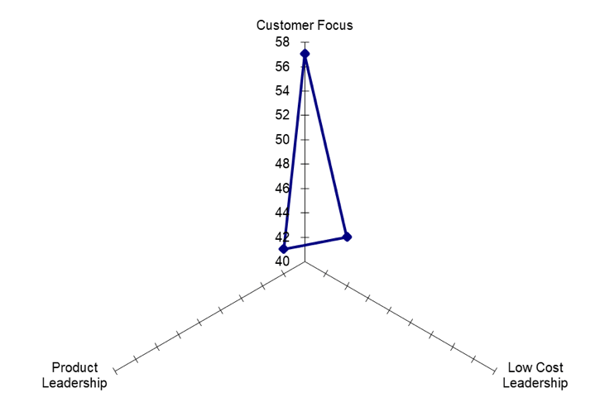CEO Blog - Advice for CEOs on growth and scaling
Selecting a Strategy for Market Leadership: Part Four

Evaluating Your Strategic Options
Hopefully, in our last two blogs (Part Two and Part Three), you have learned a great deal about the influence that your industry and coming trends will have on your company’s overall success in the marketplace.
Against the backdrop of the keen market analysis we worked through in each of the past two blogs, you now are in a position to make some tough decisions and choices. A competitive strategy must be fact-based and informed by industry analysis. By working through the steps in the previous articles, we laid a solid foundation for this strategy.
Building on Michael Porter’s theory, and the work of Treacy and Wiersema, I will stay very practical and discuss strategic options that have been demonstrated to work in the real world.
As mentioned in the introduction, there are three main competitive strategies:
- Low-cost leadership
- Product leadership
- Customer focus
To be successful, a company must consistently focus on one of them, which typically excludes excellence in the others. That’s because, in my experience, a business can achieve “world-class” excellence in one generic strategy. Though a small number of companies do well in two, nobody can excel in all three!
In a moment, we’ll zero in on behaviors under each strategy — but first, a word of caution. Every business must embody a certain minimum level of all three competitive strategies to be able to compete in a market. This minimum level is like a cover charge or “table stakes” in a poker game. For example, it does not matter how customer-focused a company is, if manufacturing costs and prices are out of whack. Likewise, customer focus is meaningless if the products on offer are of poor quality or do not perform as expected.
In the chart below, each of the axes represents a competitive strategy. The blue line is a graphic illustration of a Customer Focused company, with table-stakes levels in Low-Cost Leadership and Product Leadership. (Disregard the numbering of these items; those are holdovers from a point system used for a previous exercise, and is not important here).
Before we dig deeper into how to select a strategic posture, let us take a closer look at the specifics of each generic strategy.
Low-Cost Leadership
The low-cost leadership strategy requires a business to have a significant cost advantage over all competitors in the industry. To make the best use of plant and equipment, these companies want a high and even capacity utilization, with a strong management focus on product unit cost.
In this strategic approach, products should be standardized, without too many variations, and product lines narrow. Selling prices should be comparatively low, but profits can still be good due to low pay, economies-of-scale, and outsourcing to low-cost countries.
To ensure plants and processes are efficient, there needs to be a great emphasis on cost savings and continuous improvement. When new plants are built, processes are copied from existing plants, and experienced staff and managers are used to start up the new locations and train local workers.
Process improvement, incidentally, shouldn’t just be a priority for manufacturing. It should be vigorously pursued by R&D, Sales, Marketing, HR and other business processes as well. Customer service generally is a priority, but marginal customer accounts should be shed over time.
Low-cost leadership works best in mature industries where end-use markets are stable, new process or product development is limited, and competitive intensity is low.
It’s important to note that by being the low-cost leader, maintaining a good reputation can sometimes be a problem — since low-cost manufacturers do not always enjoy the best quality products. Building customer loyalty can be tricky when the majority of customers motivated by price. They tend to be finicky, and will switch to another supplier if their prices are lower. Also, cost leadership as a strategy is not sustainable in a dynamic industry.
Good examples of low-cost leaders can be found in automotive manufacturing. Toyota pioneered an effective production system starting in the 1930s that ultimately became the industry standard. A more contemporary example is Tesla, which has an innovative product, but also is relentless with cost containment in its plant design and process improvement activity.
Motorola, conversely, is a cautionary tale. As a pioneer in Six Sigma, they were very good at driving cost out of processes. Unfortunately, they were disrupted by the entire smartphone trend. This illustrates the table stakes idea – companies must have a minimum level of all three strategies. The ability to manufacture obsolete cell phones at lowest cost is not a platform for the future.
Product Leadership
Businesses striving to follow the product leadership strategy must have solid insights on customer needs and detailed knowledge of competitive offerings to stay ahead of the pack. No competitors can be allowed to perform at the same level; they must remain at least one step behind. Markets are segmented based on customer needs, and new products continuously developed to meet these needs.
Product leaders also tend to be price leaders, as they are very good at articulating value to customers. This is a critical component of the strategy. Product-leading companies also should place great emphasis on hiring and developing talent, and, when recruiting, should look for people with unique knowledge and experience.
Maintaining this uniqueness requires innovation and effective product development. Product roadmaps are used to allow continuous development, and facilitate the launch of a new generation of higher-performing products and services that are difficult for the competition to duplicate.
A robust product development process allows degrees of freedom in the early stages, but should become more regimented as projects progress through the Stage/Gate model. Intellectual property must be vigorously protected, both by patenting and by trade secret. Non-disclosure and non-compete agreements are widely used for assurance.
Important metrics for the product leadership strategy include volume and profitability. Both are closely tracked at the product level, with underperformers weeded out. Sales focus needs to be on adding volume through new customers; to this end, multiple channels are used, sometimes causing channel conflicts. Common examples would be distributors selling to designated house accounts, or regional distributors selling online to customers outside their territory.
A product leadership strategy is most effective in dynamic or growing industries, where the end-use markets are also dynamic. Typically, there are streams of new processes and product launches, and intense direct competition between suppliers.
Here’s an example of the Product Leadership strategy: A small software company had been spun off from a mining company that had a world-class reputation for efficiently running hard rock underground mines. A large contributing factor to this reputation was a top notch mine planning software tool, developed in house.
The principals of the new software company were allowed to retain the rights to the program they had developed. It was unique, having been built on years of planning and collaboration in this mining environment. With the parent mining company as a friendly reference, the planning tool was marketed to other large underground mines in Canada, Russia, South Africa, and Latin America. Several deals were struck with no real competition. Wins included a contract with Chile-based El Teniente, the world’s largest underground copper mine.
Customer Focus
Businesses using a customer focus strategy tend to concentrate on a specific group of customers within the broader market, offering customized products with varying degrees of complexity. This strategy is common with smaller and mid-market businesses, since they often arise from providing a specific service or a handful of products to a single large customer or small group of customers. Sometimes they start as spin-offs from larger organizations, but, in most cases, they stick to a market or application they know very well.
A lot of effort is made to generate deep knowledge about a limited set of customers and their processes. In this strategy, solutions are tailored to customer problems, also in cooperation with third parties; and the products offered are average — but good enough to solve customer problems.
Management style in a customer-focused company is empowering. Authority and responsibility are delegated to employees that are close to the customer.
A customer focus strategy is most effective in large markets with plentiful buyers and competitors. Many companies start customer-focused, but later grow into either product leaders or low-cost leaders. Some companies never make the growth leap, instead, continuing to serve a niche group of customers.
As an example of this strategy, a manufacturer of concrete floor polishing equipment provided machines, tooling, chemicals, and related products to contractors, using a direct sales force and strong customer service. The industry was fragmented, with only one contractor enjoying a nationwide reach.
The company worked for several years to become a near-exclusive supplier to this large contractor, which came to account for half of the revenue. A dedicated sales organization led by a vice president supported the large customer with sales, service, and training. The quality of the products was good, but not superior. Product modifications were readily made if the customer so desired. This, in combination with strong personal relationships, created high barriers to entry for competitors.
Evaluating Strategies
Below is the same three-axis chart we saw earlier, but now the customer-focused company is overlaid with examples of a product leader and a low-cost manufacturer. We can see that all three companies have the necessary base level of each strategic discipline, but also a clear focus on one competitive strategy.
Any of these companies can be market leaders when it comes to servicing distinct customer needs.

It isn’t a big leap to imagine what the chart would look like for a company with no strategic focus. It would exist as a small shape in the center of the chart – weak in all dimensions, literally, “stuck in the middle.” It would have a very hard time competing against any of the leaders. I am sure you can think of examples like this in your industry.
Plotting competitors is also a good way of visualizing the competitive intensity of a market. Determining what competitive strategy a competitor uses is a good help when formulating tactics. Charting also offers a visual impression of whether several businesses use a similar go-to-market strategy, in which case we might want choose a different one.
In our final blog, we will tie everything that we have covered in this series together, and help you choose a strategy that represents the right direction for your business.
Topics: CEO Marketing Strategy, Business Growth Strategy, Marketing Strategy, COVID-19
Thu, Oct 15, 2020Related Articles

- Press Releases
- Careers
- Case Studies
- Marketing Consultant Company
- Marketing Strategy Consultants
- Marketing Plan Consultants
- B2B Marketing Consultants
- Virtual CMO
- Marketing Consultant Outsourcing
- Fractional CMO
- What is a Fractional CMO
- Healthcare Marketing Consultant
- Marketing Consultant Houston TX Texas
- Marketing Consultant Texas TX
- Marketing Consultant Bay Area
- CEO Blog
- Ebooks Plus
- Executive Marketing Consultants
- Product Marketing Consultants
- B2C Marketing Consultants
- Virtual Marketing Consultants
- Senior Marketing Consultants
- Temporary CMO
- Hire a CMO
- Fractional CMO Salary
- Fractional CMO Responsibilities
- Marketing Consultant Austin TX Texas
- Marketing Consultant Dallas TX Texas
- Marketing Consultant San Antonio
- Helping Private Equity
- Private Equity Blog
- Leadership Team
- Privacy Policy
- Business Marketing Consultants
- Strategic Marketing Consultants
- Marketing Technology Consultants
- Sales and Marketing Consultants
- CMO Job Description
- CMO Salary
- Fractional CMO Agency
- Fractional CMO Services
- CPG Marketing Consultant
- Marketing Consultant San Diego
- Partners
Houston, TX 77056
© 2023 Chief Outsiders



